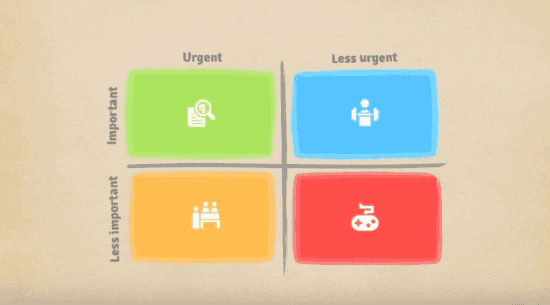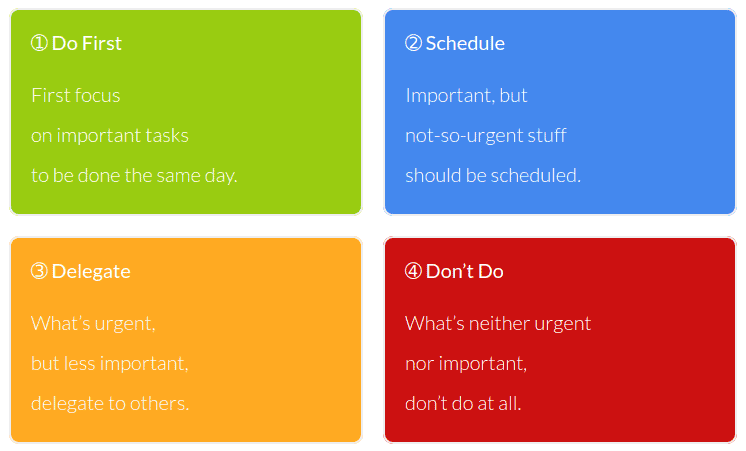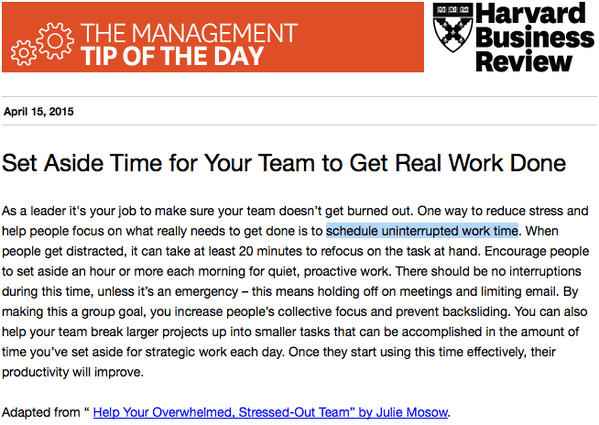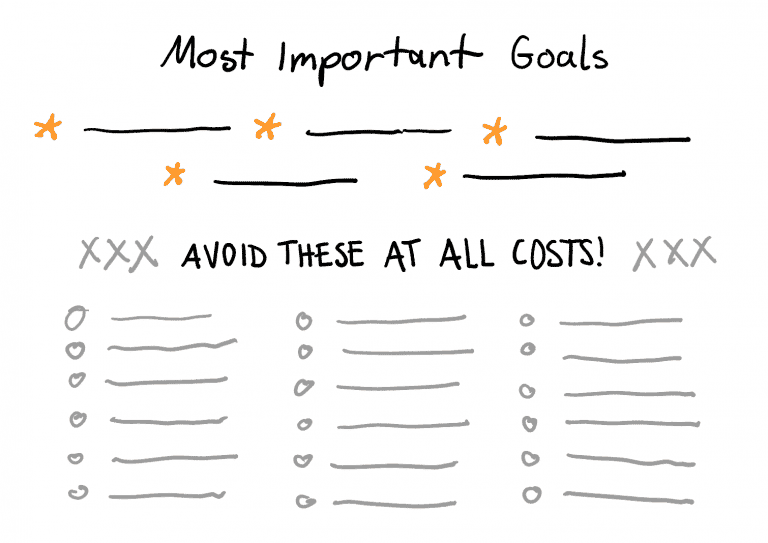How to prioritize tasks (and stop putting out fires)
Even before COVID shifted us to thinking about a “New Normal,” people were stressed at work. Four years ago, Groupon commissioned a study of 2,000+ professionals about their work lives. Some findings:
- 20% of the respondents said they worked 10 hours/day
- 60% of the respondents said there wasn’t enough time in the day to do everything
- 50% said workload was preventing them from work-life balance
- 53% said they still had significant financial concerns
- On a 1-10 scale, stress at home averaged a 5; at work, it averaged a 6.4
More recently, about four months into a global pandemic, researchers at Harvard and NYU collected data from three continents on working styles. That data found that workdays have increased almost 50 minutes (more for women) and meetings are up 13%, with email sends rising as well. (The good news was that meetings tend to last a shorter amount of time.)
In sum, then, there’s a lot of work. Ezra Klein, the founder of VOX Media, released a podcast last year on how “work is identity, and burnout is lifestyle.” Many people feel this way, and tasks seem to pile up.
That’s just work, as well. There’s also the rest of your life: friends, family, aging parents, potentially children, pets, volunteer commitments, happy hours, and more.
People get busy. There are a lot of events and tasks. A core question of the modern age is how to prioritize tasks. What does research and example teach us?
The Eisenhower Matrix
One popular approach around how to prioritize tasks is the Eisenhower Matrix, named for the former U.S. President. In the matrix, you consider tasks as “urgent” and/or “important,” and it looks like this:

The top left quadrant, where “urgent” and “important” intersect, are things you do first, i.e. that day. An example might be a project deadline.
One quadrant over, “important” but “less urgent,” should be scheduled. That could be a teeth cleaning or a meeting about a project down the line.
The lower left quadrant, “urgent” but “less important” (which is very common at work, where “sense of urgency” is a commonly-used phrase), can be delegated to others. This might include the scheduling of candidate calls, or lower-level projects.
The final quadrant, less urgent and less important, honestly doesn’t need to be done at all.

That’s one way to conceptualize how to prioritize tasks. What else is there?
How to prioritize tasks: Batching
Batching is essentially dividing up your day: you might write in the morning and research in the afternoon, for example, or cluster meetings in the morning and work on product development in the afternoon. Batching tasks allows you to singularly focus on one concept or idea, which some call “flow,” as opposed to being interrupted by constant pings for a multi-hour period.
One of the easiest ways to “batch” in a standard work environment is to block off your calendar for a few hours and not let anyone schedule over it. That’s been a Harvard Business Review “Tip of the Day” too:

ABCDE Method, or grading
In this method of how to prioritize tasks, you create a task list for a given day. Then, you go through it and assign everything a letter grade from A (most important) to E (least important). Then reorganize the list with As on top, which is sometimes called the “Eat the Frog” method of time management and how to prioritize tasks, i.e. no one loves eating the frog (gross), but do it first thing in the morning. Human beings tend to be more productive and focused in the morning, so tackling the important pockets of tasks then makes sense.
This method is similar to the Eisenhower Matrix in that you’re thinking about how to prioritize tasks in the context of importance and urgency.
The Ivy Lee Method
Crazily enough, this method on how to prioritize tasks was developed 100+ years ago and yet, modern productivity experts still recommend it. There are a simple set of rules:
- At the end of a given day, write down the six (6) most important things you need to do the next day. No more than six. It can be all work, all personal, or a mix.
- Prioritize those six items 1-6.
- The next day, at work (or in your personal life), start on the No. 1 task. Only focus on that task. Do not move to Task No. 2, or any other tasks on the list, until No. 1 is done.
- Move this way through Task 2, Task 3, etc.
- At the end of the day, anything you didn’t finish can be moved to the next day.
- Keep repeating.
Warren Buffett’s two-list rule
Everyone likes a good Warren Buffett piece of advice, right?
His two-list rule on how to prioritize looks like this: write down 25 total goals you have. You can do this at the start of a month, year, quarter, or even week (although 25 goals for a single week is lofty). Pick the five most important and elevate those to a level above the list, numbered 1-5. Then circle the other 20 and write “Avoid at all costs.”

Now you know where your focal points should be, and everything else is essentially a distraction. Rumor has it that Buffett worked with his personal pilot on the two-list rule to help him figure out how to prioritize tasks and career goals.
Throw away the sunk cost fallacy
The sunk cost fallacy is a psychological construct whereby we think that because we’ve previously invested time and effort into something, we need to keep doing it and can’t give it up. A classic example in companies is weekly meetings that have long since become irrelevant, potentially created years ago when someone missed a project deadline, and yet everyone still traipses into them each week, not really sure why they need to last an hour. You can kill these meetings.
You can kill many unnecessary things off your calendar, in all likelihood. You can stop doing things at work, especially, “because it’s how we’ve always done it.” It will help you be less cluttered and better understand how to prioritize tasks.
How to prioritize tasks: Be a “time multiplier”
This is someone who asks this question: “What could I do today to make tomorrow better?” We regularly assign that type of discussion and questioning to entrepreneurs, but anyone can do it. It’s a shift from some of these other approaches because instead of focusing on tackling that day in front of you, you look at that day in the context of the overall week, month, quarter, year, etc.
What could you do now to make tomorrow easier, better, or more efficient? Could you schedule out two weeks of email marketing so that you don’t have to scramble on each one?
Are there elephants in the room of how to prioritize tasks?
Absolutely. For example:
- You could have a “sense of urgency” manager: In such a case, every single task or project is completely urgent, even if he/she has already presented you with 12 other projects, all also deemed urgent. If an organization has this problem at scale, it’s up to senior leadership to develop the people management skills of their front-line managers. If you have a manager like this, sit down with them and explain all the projects they’ve presented, and ask for clarity in prioritizing them. If this doesn’t work over time, it’s time to find a new job, because it’s not fair to your stress levels. (That’s easier said than done because of pandemic, but continue to try and work with them on setting clear priorities.)
- You might be a Type-A personality who wants everything done perfectly: That isn’t inherently a bad thing! In that case, use the Ivy Lee approach or something similar, where you only focus on one task at a time until it’s completed to satisfaction, and then move to the next task. There will always be more tasks, at work and personally. You will get to them.
- You might not know what’s important: This is increasingly common as people are getting laid off, being locked down, and more. The goalposts for “what really matters” seem to move. Sit down with yourself and see where you want to be in 1 year, 3 years, 5 years, etc. Talk to your partner if you’re in a relationship. Talk to friends. Talk to trusted colleagues. Then start to drive priority off that, which will help you determine how to prioritize tasks.
- You have a manager fond of arbitrary deadlines: Many of us have experienced this, where deadlines are essentially created in a vacuum without the context of what other deadlines are looming (or deadlines from other managers). Again, sit down with the manager and explain what’s coming up and ask for priority on which tasks can be pushed out a little bit. If nothing can, see if others on your team or an adjacent team can help out.
- Big Picture vs. detail-oriented thinking: Often, if you focus on how to prioritize tasks, you will mold yourself into a very detail-oriented thinker. This is good! The devil is in the details, right? The unfortunate flipside is that a detail-driven focus often makes it harder to see the big picture, because detail-oriented people tend to view all details and tasks as important. Rather, if you can increase your capability for big picture thinking, how to prioritize tasks becomes easier. Why? Because when looking at the big picture vs. every single detail, you more instinctively know what’s urgent and what’s not.
Could you use technology for task prioritization?
Of course, and many do. Trello is one predominant tool, whereby you organize your tasks into “boards” (usually days of the week or bigger categories such as “product development”). Monday has become more popular recently. Asana is a good tool for team organization.
There are hundreds of these tools, many geared towards how to prioritize tasks at work, but most of them can be used in a personal context as well, i.e. “Pick up kids from soccer.” Pipefy and Wrike are other players in the space. Plan is a tool that allows you to create a master to-do list and then drag and drop specific to-dos into your calendar throughout the day.
At F4S, we allow you to take a free assessment measuring 48 distinct traits of individuals and teams. This helps teams come together better, which makes it easier to understand where true urgency and importance lie in terms of projects. If you combine that with developing managers and teaching them what tends to motivate employees, you will evolve into a team with a clear sense of priority, boundaries, and generally less-stressful lives. There will always be tasks and goals and urgent deadlines, but if they can be managed in a logical, respectful way, teams will thrive.
The bottom line on how to prioritize tasks
This isn’t easy for people, especially in a work context: by some measure, only 8% of leaders successfully align strategy and execution. Many of them don’t always know how to prioritize what matters, and create overlapping, low-priority, oft-redundant tasks. So, the process is an uphill battle for many.
But with some of the approaches above, and a renewed focus on managerial development, team-building, and a sense of both personal and professional purpose, you can become a master of how to prioritize tasks.
Learn how to prioritize tasks effortlessly with fast personal coaching — get started for free today.
Learn to prioritize better and see the big picture with AI coaching.
Our programs were designed by world-renowned coaches. Sessions only take 5-15 minutes. Get started for free with your personalized program now.
My coaching Plan:
Our expert coaches have designed hyper-effective programs that will help
you learn how to prioritize tasks.
Coach Marlee (your amazing AI-powered personal coach) will analyse your unique traits and goals to let you know which program to start with (and if there are any you should skip)!
Your recommended programs include:
My Coaching Plan:
Our expert coaches have designed hyper-effective programs that will help you improve your mental health, wellbeing, productivity, leadership and more.
Coach Marlee (your amazing AI-powered personal coach) will analyse your unique traits and goals to let you know which program to start with (and if there are any you should skip)!
Your recommended programs include:

Team Building
Take your teaming to the next level in this high impact 9-week team coaching program with Coach Marlee. Discover and optimize complementary strengths and unique talents with your team, reach decisions together quickly, enjoy team cohesion, high energy and motivation as a bonded team.

Attention to Detail
Impress yourself and others with your attention to detail! Develop a genuine appreciation, energy and stamina for detailed thinking to execute your vision, measure performance in yourself and others while also accelerating your ability to learn and change.

Personal Power
In this high impact eight week program Coach Marlee will help you increase your comfort and confidence to be in positions of influence and leadership, navigate organizational politics and also help you develop greater confidence to compete and influence at the top of your industry or field.

Multiply Your Impact
Multiply your impact by embracing the experience and genius within others. During this eight week program Coach Marlee will help you to develop a genuine appreciation for experimentation and data and a willingness to empower the opinions, feedback and insights within your team and others in your life.

Trust Your Gut Feel
Explore, strengthen and stand by what you believe in at work and in life. Trust in your ‘gut feel’ and point of view is especially helpful for influencing, starting your own business, having your personal needs met and for living an authentic and meaningful life.

Big Picture Thinker
Inspire yourself and others to see the bigger picture! Increase your comfort and use of abstract and strategic thinking to gain a broader perspective in work and life. Big picture thinking is key in communication, leadership, businesses, selling, marketing, and situations where you need to get the gist of things quickly.

Reflection & Patience
Develop ‘step back’ mastery for increased self-awareness and developing mindsets and tools for constant improvement. Reflection and patience is core to consolidating learning, development, strategic thinking, recharging and living an authentic and meaningful life.

Start Fast
Close the gap between your great ideas and starting them. Energy and drive for starting is key for inventing new things, starting businesses, selling, marketing, socializing or in situations where you need to think on your feet.

Increase EQ
Explore, develop or strengthen your emotional intelligence (EQ). Awareness of your and others’ emotions is at the heart of influencing, ‘reading people’, impactful communication, deep relating and authentic connection at work and in life.

Goal Catcher
Inspire yourself and others to see and achieve grand visions and goals. A focus on goals is especially helpful for inspirational leaders, starting your own business, impactful communication, or for achieving awesome outcomes at work and in life.
Testimonials

“Personal power program was great for me to gain confidence and knowledge on approaching my new leadership role”

“I learned how to set, move to take action and progress towards happiness”

"Marlee really helped me to understand how to cue in on body language and tone when speaking with others, in order to connect on a deeper level"

"With attention to detail program, I learned a whole new way to see and approach projects"

“I was able to see that I would still like to direct and author my decisions more effectively”

“This program helped me kickstart my journey to wellbeing. Never could I have imagined an AI coach being this good - as if you're talking to a real human and how Marlee made me accountable to my goals. Super awesome experience that you definitely got to try!”

"The resources are awesome, I have referred back to them multiple times"

“Awesome and effective coaching program of helping to increase motivation for goal challenged people. Fallen in love with goals and looking forward to more BHAGs. Highly recommend the coaching for GoalCatcher!”
Related Articles
What’s your communication style?
Learn how to connect with colleagues and boost workplace motivation.

Name Surname
Position, Company name

Name Surname
Position, Company name

Name Surname
Position, Company name

Name Surname
Position, Company name

Name Surname
Position, Company name

Name Surname
Position, Company name
Your submission has been received!

Hack your wellbeing, productivity and goals
Programs are created by expert coaches & delivered by our incredible A.I. Coach Marlee. Sessions only take 5-15 minutes and are 100% personalized to fit your unique traits and goals.
